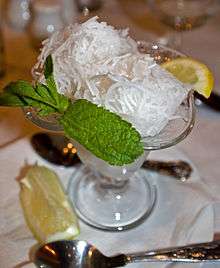Faloodeh
Faloodeh (Persian: فالوده, romanized: fālūde) or Paloodeh (Persian: پالوده, romanized: pālūde) is a traditional Iranian cold dessert similar to a sorbet.[1][2] It consists of thin vermicelli-sized noodles made from starch in a semi-frozen syrup containing sugar and rose water.[3][4][5] Faloodeh is often served with lime juice and sometimes ground pistachios.
 | |
| Alternative names | Faludeh, Paloodeh, Paludeh, Fālūdhaj |
|---|---|
| Type | Dessert |
| Course | Lunch & Dinner |
| Place of origin | Shiraz, |
| Main ingredients | Vermicelli, syrup (sugar, rose water) |
In Iran, faloodeh is sold in ice cream stores and coffee shops in flavors such as pistachio, saffron, rosewater and honey, and can be served alongside bastani sonnati, a traditional Persian ice cream. Shirazi faloodeh (Persian: فالوده شیرازی, romanized: fālūde Shirāzi), the version from the city of Shiraz, is particularly well-known.[6]
History
The Persian word paloodeh is from the verb paloodan (Persian: پالودن) which means to refine. Faloodeh is an Arabicized form of paloodeh that appeared after the Arab conquest of Iran, due to a lack of the phoneme /p/ in Standard Arabic.[7][8][9]
In the 16th to 18th centuries, the Indo-Persian Mughal kings who ruled South Asia created a cold dessert beverage called falooda, which is a derivative of faloodeh.
Preparation
A thin batter of starch (from potatoes, arrowroot, maize, or rice) is cooked, then pressed through a sieve producing delicate strings similar to cellophane noodles, that are then chilled in ice water.[3][4] Afterwards, they are combined with the syrup mixture and rapidly cooled until the syrup is at least half-frozen.
See also


References
- Dan Jurafsky (November 16, 2011). "Macarons, Macaroons, Macaroni: The curious history". Slate.
- Krondl, Michael (2011). Sweet invention : a history of dessert. Chicago, Ill: Chicago Review Press. ISBN 1-55652-954-6. page 102.
- "Recipe: Faloodeh (Persian Rose Water Ice)". Kitchn. Retrieved 2017-06-12.
- Dalal, Tarla (2000-09-01). Chaat Cookbook. Sanjay & Co. p. 96. ISBN 9788186469620.
- Sinaiee, Maryam (2015-05-10). "Faloodeh: Persian Rosewater and Lemon Sorbet". The Persian Fusion. Retrieved 2017-06-12.
- Marks, Gil (2010-11-17). Encyclopedia of Jewish Food. Wiley. ISBN 9780544186316.
- Spooner, Brian (1994). "Dari, Farsi, and Tojiki". In Marashi, Mehdi (ed.). Persian Studies in North America: Studies in Honor of Mohammad Ali Jazayery. Leiden: Brill. pp. 177–178.
- Spooner, Brian (2012). "Dari, Farsi, and Tojiki". In Schiffman, Harold (ed.). Language policy and language conflict in Afghanistan and its neighbors: the changing politics of language choice. Leiden: Brill. p. 94.
- Campbell, George L.; King, Gareth, eds. (2013). "Persian". Compendium of the World's Languages (3rd ed.). Routledge. p. 1339.